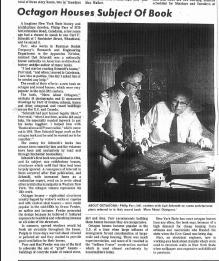
As of early August, 2004, the focus of this web site will primarily be to inventory older octagon, hexagon, and round houses, including lighthouse keeper houses, in the U.S. and Canada, with an emphasis on their history when available. A rough rule of thumb is houses built before 1950. In practice, this will mostly mean 85 years or so ago, since apparently few octagon and hexagon houses were built in the US between about 1915 and 1950. Older octagon and hexagon school houses, mostly occurring in eastern Pennsylvania, and to a lesser extent in New Jersey and New York, will also be kept, and new listings added when and if they become available. Often as not the structures were turned into homes as the days of the small school building ebbed. The structure of the site will otherwise not change. These changes strictly reflect my own interests.
Originally the largest single source data source was the list privately published
by a Rochester NY architect, Carl F. Schmidt, as The Octagon Fad, 1958.
Left click on the image below for a larger version.
The goal for those houses still known is to provide as much information as possible for each one, including its history, historical photographs, and floor plans. For the time being the priority is just to get basic data on as many buildings as possible, in part to ensure that they do not fade from memory before they are listed. Information about a house can be added more easily than determining that a house now gone ever existed. Recent changes to copyright laws make it likely that few will live long enough to see older books containing photographs enter the public domain. But unencumbered photographs of all ages for inclusion on this site are very welcome. Digital cameras are made to order for a project like this, and people are encouraged to e-mail photos of possible interest.
It's plausible that most of the standing octagon houses are already part of the inventory. Photographs are still needed for many. Locating information about houses that once existed is a challenge. Over time it's hoped that older books on architecture, local histories, historical societies, and historians, will provide more leads. I know of two houses in my own home town that each disappeared 45 or more years ago, and with this knowledge can turn up photographs and other details. But without knowing at least this much progress will remain elusive, and subject to luck.
Areas of hope include book scanning projects, like the one Google has embarked on. It includes the old proceedings of historical societies, and the scans have been process with character recognition software so the test can be searched. This has already yielded results for both standing and no longer standing houses. Satellite images provide the ability to both find and verify the existence of houses, expecially in smaller towns. Goggle and others are also scanning old newspapers and magazines, and these too will likely provide new entries to the inventory as these kinds of projects evolve.
The realization has recently emerged that almost all standing houses are but shells of the original homes. In almost all cases the porches, containing vast amounts of lumber, have long since rotted away, and are now too expensive to replace. In many cases the cupolas are gone, and so is much of the ornate wood trim - "gingerbread" - that was orginally part of the house. The paints of the 1850s and 1860s provided some color - mostly red, yellow, white, blue, green, and black - but almost no protection. The paints were usually made of oxides of metals.
The expectation was that when the wood inevitably rotted away, it would be replaced. Hardwoods were essentially free in the 1850s and 1860s, but then, all of a sudden, they were mostly gone, and expensive.
So most standing houses lack the original porches, and sometimes the cupolas and wood trim. This makes early photographs of the houses particularly valuable. Often, what stands today is a rather naked version of the orginal house. On the inside, rarely available for the inventory, the houses have often been hacked up in to apartment units, if because they now reside in declining neighborhoods. As a result, the few examples that have been restored based on good historical data are particularly valuable today. The rest are continually in danger of being razed, or used for fire practice, because their condition and location no longer attracts restoration efforts.
Send e-mail to either R. Kline or E. Puerzer.